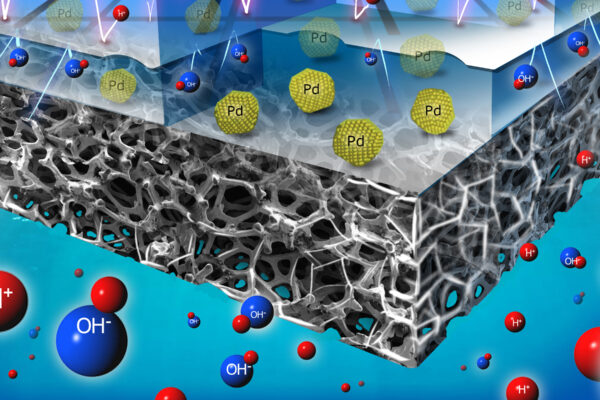Advancing the capability of high-powered fuel cells
A team of engineers in the McKelvey School of Engineering has developed a high-powered fuel cell that operates at double the voltage of today’s commercial fuel cells. It could power underwater vehicles, drones and eventually electric aircraft at a significantly lower cost.
Major Indo-U.S. Advanced Bioenergy Consortium launches
The government of India’s Department of Biotechnology,
Indian corporate leaders and Washington University in St. Louis have
invested $2.5 million to launch the Indo-U.S. Advanced Bioenergy
Consortium for Second Generation Biofuels (IUABC). The goal of the center is to increase biomass yield in
plants and algae, enabling downstream commercial development for
cost-effective, efficient and environmentally sustainable production of
advanced biofuels.
Celebrating Earth Day at School of Medicine
Jim Jackson (left), project manager in Facilities Management at the School of Medicine, explains energy used in light bulbs to a visitor to the energy conservation and alternative energy station at the School of Medicine’s Earth Day festivities April 19 in the BJC Institute of Health Hope Plaza. In addition to energy, visitors learned about recycling, gardening and water conservation, and transportation and clean air.
School of Medicine Earth Day celebration April 19
Earth Day activities at the School of Medicine will take place from 10:30 a.m.-1:30 p.m., Thursday, April 19. All faculty, staff and students are encouraged to take part to learn about energy conservation and alternative energy; recycling; gardening and water conservation; and transportation and clean air.
WUSTL students return from International Experience in China and Hong Kong
This summer students participating in the McDonnell Academy Global Energy and Environmental Partnership (MAGEEP) International Summer Experience traveled to the Shenzhen-Hong Kong metropolitan area to learn about alternative energy research and practice but also to explore the festivals, museums and food of another culture.
Set energy goals and reach them
Wind power is one practical alternative to petroleum.The director of a sustainable energy research center at Washington University in St. Louis is challenging President-elect Barack Obama to set goals in energy research and implementation. “I would like to see the next president of the United States set a similar goal to President Kennedy’s from 1961 — to put a man on the moon and to bring him back to Earth by the end of the decade,” says Himadri B. Pakrasi, Ph.D., the George William and Irene Koechig Freiberg Professor of Biology in Arts & Sciences, and Professor of Energy in the School of Engineering and Applied Science.
Set goals and reach them
Wind power is one practical alternative to petroleum.The director of a sustainable energy research center at Washington University in St. Louis is challenging the next president of the United States to set goals in energy research and implementation. “I would like to see the next president of the United States set a similar goal to President Kennedy’s from 1961 — to put a man on the moon and to bring him back to Earth by the end of the decade,” says Himadri B. Pakrasi, Ph.D., the George William and Irene Koechig Freiberg Professor of Biology in Arts & Sciences, and Professor of Energy in the School of Engineering and Applied Science.
Biogas production is all in the mixing
David Kilper/WUSTL PhotoMuthanna Al-Dahhan (left) and graduate student Rajneesh Varma are researching effective ways to take agricultural waste and make biofuel out of it.Engineers at Washington University in St. Louis, using an impressive array of imaging and tracking technologies, have determined the importance of mixing in anaerobic digesters for bioenergy production and animal and farm wastes treatment. They are studying ways to take “the smell of money,” as farmers long have termed manure’s odor, and produce biogas from it.

